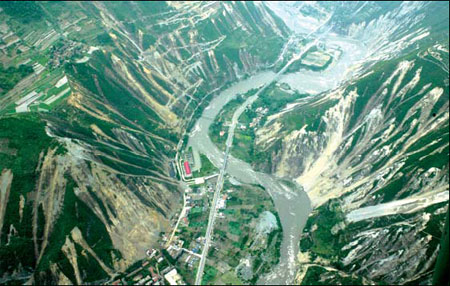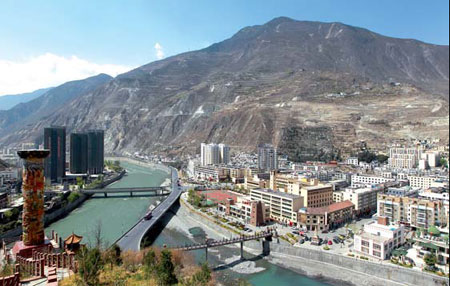13 towns have a rebirth
Updated: 2013-05-10 08:52
(China Daily)
|
|||||||||||
|
An overview at the valley where Yingxiu town sits on May 28, 2009 shows extensive damage by the earthquake. Huang Yiming / China Daily |
|
Wenchuan county is restored at its original location. Cui Meng / China Daily |
Underdeveloped settlements surrounding the Wenchuan quake's epicenter have been rebuilt to resemble areas in advanced countries.
Reporters for thisS section
Erik Nilsson, Huang Zhiling, Fu Jing, Hu Yongqi, Guo Anfei, Cao Huan, Liu Xiangrui, Zhang Yue, Zhang Haizhou, Chen Jia, Sun Ye, Yu Yilei
Wenchuan
Editor's note: The tremor's destructive force created an enduring legacy in Wenchuan. The county has been rebuilt and is more accessible to the outside.
Ding Yishu says her reconstructed hometown is no different from the European settlements she has seen on TV. But that wasn't the case before the 2008 earthquake devastated her native Wenchuan county, which sat at the epicenter of a disaster that left up to 90,000 dead or missing.

The 78-year-old and her husband Ma Dechang now live a "healthy" and "ordinary" retired life.
"The town's total facelift has made life easier for the elderly," Ding says.
The retired teacher and her husband live in a two-bedroom apartment in a new residential area. They attend Friday prayers with other Muslims in a recently constructed mosque.
Getting from Wenchuan to Chengdu, the provincial capital, used to entail a tortuous half-day journey through mountainous terrain. But now the trip takes just an hour on a newly built highway.
In addition, much easier access to the outside world and a scenic riverside road in the county's township, schools, hospitals and residential buildings have been meticulously planned and built.
None of the 13 townships in the county, which was at the epicenter of the earthquake, escaped the devastation.
Later, 13 cities in China's wealthiest province, Guangdong, were designated to help rebuild the 13 Wenchuan towns.
The province has allocated 11.2 billion yuan ($1.72 billion; 1.31 billion euros) for 702 reconstruction projects in Wenchuan, and thousands of builders from Guangdong have been involved in the reconstruction effort for Wenchuan's 100,000 people.
"Reconstruction has left us with legacies that will help locals become even richer," says Li Daijun, an official with the county's legislative body.
Towns near the epicenter, such as Yingxiu, Shuimo and Shanjiang, have become tourist attractions and have even been given AAAA ratings because of the reconstruction effort, Li says.
Shuimo is a 20-minute ride away on the mountainous road from Yingxiu, which was at the epicenter. Ninety-two people died in Shuimo, and its infrastructure was destroyed.
As planning was made for its reconstruction, Peking University and Foshan city in Guangdong decided that it should be turned into an environmentally friendly tourist draw.
That has entailed embracing low-carbon emissions. The work was honored as the world's best implementation of post-disaster reconstruction two years ago at the Sixth Global Forum on Human Settlements in New York.

The tiny town has tile-roofed wooden buildings of the Qiang ethnic group, and stores selling Qiang handicrafts are arranged along snaking stone alleys. Yuan Shunyan, 40, sells embroidery and local specialties in a 36-square-meter shop in the town.
"Business is not bad because the town has become well known," says Yuan, who moved from a nearby village two years ago.
The benefits of post-quake recovery and reconstruction are not restricted to towns.
Zhang Fagui heads Qishan village in Shanjiang town, a habitation protection zone for pandas. Nearly all the village's houses, most of them in a poor state of repair when the quake struck, were flattened.
With government grants and interest-free loans, 96 families have been able to rebuild in the village, which is about 2,000 meters above sea level.
To protect the environment, villagers have been required to stop farming and plant trees.
"After reconstruction, we urgently needed to find ways to increase income," says a local surnamed Zhang, adding that agricultural subsidies are not enough.
With the help of Oxfam Hong Kong, 40 households in Zhang's village have started frog farming and plan to expand the planting of traditional Chinese medicine plants.
"All of that means more income and reducing our dependency on natural resources," Zhang says.
"That helps pandas, too."
(China Daily 05/10/2013 page23)
Today's Top News
List of approved GM food clarified
ID checks for express deliveries in Guangdong
Govt to expand elderly care
University asks freshmen to sign suicide disclaimer
Tibet gears up for new climbing season
Media asked to promote Sino-Indian ties
Shots fired at Washington Navy Yard
Minimum growth rate set at 7%
Hot Topics
Lunar probe , China growth forecasts, Emission rules get tougher, China seen through 'colored lens', International board,
Editor's Picks

|

|

|

|

|

|







